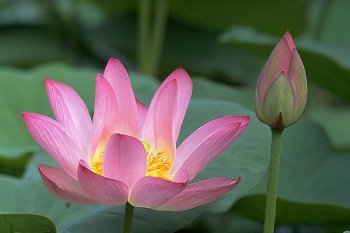Part Four - OUTLINE OF THE SUTRA
Content
4.1 Form and Style of the Sutra
4.2 Content of the Sutra
4.3 Three Assemblies in Two Places
4.4 Two Introductions Three Sections (by Chih-che)
4.5 Three Sections (by Gui Ji)
4.1 FORM AND STYLE
According to the translated text by Kumarajiva, the Lotus Sutra is divided
into 28 Chapters in 7 fascicles.
From Chapters 1 to 21 and Chapter 25 of the Sutra, almost everything is said
first in prose, then in verse. The remaining chapters are without the verse
repetition. The verse part generally follows the tenor of the prose discourse.
It is believed that the verse form was used to facilitate the reciters to
memorize the teachings and transmit to others.
The principal teachings of the Lotus Sutra are often very beautifully and
persuasively expounded, especially in the various parables for which the Lotus
is famous. Certainly, the Sutra gains high literary merit.

4.2 CONTENT OF THE LOTUS SUTRA
|
Chapter
|
Title
|
in Sanskrit
|
|
1
|
Preface
|
Nidana
|
|
2
|
Expedient Devices
|
Upayakausalya
|
|
3
|
A Parable
|
Aupamya
|
|
4
|
Belief and Understanding
|
Adhimukti
|
|
5
|
Medicinal Herbs
|
Osalhi
|
|
6
|
Conferring Predictions
|
Vyakarana
|
|
7
|
The Analogy of the Transformed City
|
Purvayoga
|
|
8
|
Five Hundred Disciples Receive Predictions
|
Pancabhiksu satavyaarana
|
|
9
|
Bestowing Predictions upon Those Studying and Those Beyond Study
|
Vyakarana
|
|
10
|
Masters of the Dharma
|
Dharmabhanaka
|
|
11
|
Vision of the Jeweled Stupa
|
Stupasamdarsana
|
|
12
|
Devadatta
|
Devadatta
|
|
13
|
Encouraging Devotion
|
Utsaha
|
|
14
|
Comfortable and Peaceful Practice
|
Sukhavihara
|
|
15
|
Emerging from the Earth
|
Bodhivat vaprthivi vivara samudgama
|
|
16
|
The Life Span of the Thus Come One
|
Tathagata-yuspramana
|
|
17
|
Distinction in Merits
|
Punyapayaya
|
|
18
|
The Merits of Responding with Joy
|
Anumodanapunya nirdesa
|
|
19
|
The Merits of the Dharma Master
|
Dharmabhanakanu samsa
|
|
20
|
The Bodhisattva Never Desparaging
|
Sadaparibhuta
|
|
21
|
Supernatural Powers of the Thus Come One
|
Tathagatarddhyab hisamskara
|
|
22
|
Entrustment
|
Anuparindana
|
|
23
|
Former Affairs of the Bodhisattva Medicine King
|
Vaisajyarajapur vayoga
|
|
24
|
The Bodhisattva Wonderful Sound
|
Gadgadasvara
|
|
25
|
The Universal Gateway of the Bodhisattva Perceiver of the Sounds of
the World
|
Samantamukha
|
|
26
|
Dharani
|
Dharani
|
|
27
|
Former Affairs of King Wonderful Adornment
|
Subhavyuharaja purvayoga
|
|
28
|
Encouragement of the Bodhisattva Universal Worthy
|
Samantabhadrot sahana
|
4.3 THREE ASSEMBLIES IN TWO PLACES
According to the Lotus Sutra, Shakyamuni Buddha held Three
Assemblies in Two Places.
- First Assembly in Vulture Peak (Mount Grdhrakuta) - from Chapter 1 to
first half of Chapter 11.
- Second Assembly in the sky - from the second half of Chapter 11 to Chapter
21.
- Third Assembly in Vulture Peak (Mount Grdhrakuta) again - from Chapter
21 to Chapter 28.
4.4 TWO INTRODUCTIONS THREE SECTIONS
(BY CHIH-CHE)
According to Chih Che of Tien Tai School, the
Sutra can be divided into Two
Introductions and Three Sections.
The Two Introductions
are:
1. Introducing
the Traces
In the first 14 chapters, Shakyamuni taught and transformed his disciples
and living beings in this world. It means
Manipulating the provisional for the sake of the real
Opening the provisional to reveal the real
Annulling the provisional to establish the real
Amongst the 14 chapters, chapter 2 is the most important.
2. Introducing the Origin
In the remaining 14 chapters, Shakyamuni explained his
causes and effects in the attainment of Buddhahood in his many past lives,
and the Bodhisattvas also narrated their experience in cultivation by upholding
the Sutra. It means
Showing the traces for the sake of origin
Opening the traces to reveal the origin
Annulling the traces to establish the origin
Amongst the 14 chapters, Chapter 16 is the most important.
For Introducing the
Traces, there are Three Sections:
1. Preface Section (Chapter 1)
The Buddha emitted rays of white light from his eyebrows
illuminating the entire eastern world.
Maitreya raised doubt and requested answers. Manjushri
certified the present conditions by his past experience.
2. Proper Section (Chapter 2 to 9)
Upon the request of the disciples, the Buddha spoke the
Dharma three rounds. The Sound Hearers received the predictions from the
Buddha, then they returned
from the Small to the Great."
- Chapter 2 & 3 - to explain the doctrine of the
Three Vehicles converging to One Buddha Vehicle", so that those
of superior roots are enlightened. This is the first round of speaking
of Dharma.
- Chapter 3, 4, 5 & 6 - to explain with a parable of the
Three Carts is the One Great Cart" so that those of average roots
are enlightened. This is the second round of speaking of Parable.
- Chapter 7, 8 & 9 - to explain the causal conditions in the past
lives with an analogy of the
Transformed City", so that those of inferior roots are enlightened.
This is the third round of speaking of Causal Conditions.
3. Circulating Section (Chapter 10 to 14)
Shakyamuni praised people who circulated and also glorifying
the Sutra. The Sutra is certified by the emergency of Many Treasures
Buddha with his Stupa. The Dragon Lady becomes Buddha in the
presence of the Buddha. Thus, Bodhisattvas make vows before Shakyamuni,
and all converge to One Buddha Vehicle.
For Introducing the
Origin, there are also Three Sections:
1. Preface Section (First half of Chapter 15)
Bodhisattvas who emerge from the ground make vows to propagate
the Sutra in Saha world.
2. Proper Section (Second half of Chapter 15
& 16)
Shakyamuni narrates his attainment of Buddhahood in his
many past lives, and also his boundless power.
3. Circulating Section (Chapter 17 to 28)
The Buddha praises the meritorious cultivation of the great
Bodhisattvas, who set good examples for the coming Bodhisattva. Further
to the encouragement of the Universal Worthy Bodhisattva, the perfect, complete
and supreme Dharma assembly is adjourned.
- The merits and virtues of upholding the Sutra in faith (Chapter 17,
18, 19 & 20)
- The entrustment of the Buddha (Chapter 21 & 22).
- Sagely effect from sagely cause (Chapter 23, 24 & 25).
- Protection of the Sutra and encouragement in cultivation by upholding
the Sutra (Chapter 26, 27 & 28).
4.5 THREE SECTIONS (BY GUI JI)
According to Gui Ji of Dharmalasaka School,
the Sutra is simply divided into three sections:
1. Preface Section (Chapter 1)

2. Proper Section (Chapter 2
to 20)
To explain the One Buddha Vehicle in three aspects:
2.1 The wonderful realm of Real Mark of One Buddha
Vehicle (Chapter 2 to 13).
2.1.1 Opening provisional to manifest real", thus
all three roots receive predictions
- Chapter 2 & 3 - to explain the doctrine of The
Three Vehicles converging to One Buddha Vehicle", so that those
of superior roots are enlightened. This is the first round of speaking
of Dharma.
- Chapter 3, 4, 5 & 6 - to explain with a parable of
The Three Carts is the One Great Cart" so that those of average
roots are enlightened. This is the second round of speaking of Parable.(iii) Chapter
7, 8 & 9 - to explain the causal conditions in the past lives
with an analogy of The Transformed City, so that those of inferior
roots are enlightened. This is the third round of speaking of Causal
Conditions.
2.1.2 Praising people & glorifying Dharma, thus encouraging
to uphold and practice
- Chapter 10 - praising people and glorying Dharma.
- Chapter 11 - certifying the present with the past.
- Chapter 12 - receiving prediction without discrimination.
2.1.3 Annulling provisional to establish real (Chapter
13)
2.2 The wonderful cultivation in One Buddha Vehicle (Chapter 14
& 15).
2.3 The wonderful fruition of One Buddha Vehicle (Chapter 16 to
20)
3. Circulating Section (Chapter 21 to 28)
To elaborate the meaning of the realm, cultivation and
fruition of One Buddha Vehicle.
|












